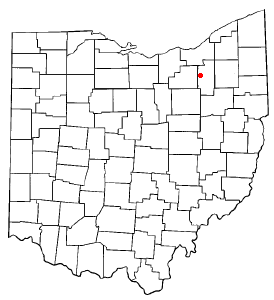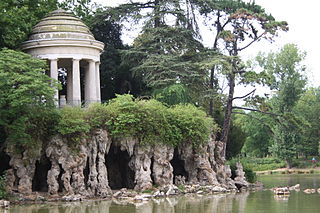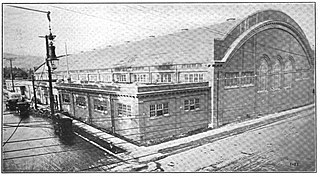
Montrose is an unincorporated community on the border between Bath Township, Copley Township, and the city of Fairlawn in Summit County, Ohio, United States. It is an area of restaurants, stores, and businesses located along a stretch of State Route 18 near Interstate 77. The community is served by the Fairlawn (44333) post office. It is included in the Montrose-Ghent census-designated place. It had been a quiet hamlet for much of its history, with such establishments as a drive-in theater, golf courses, and a church. It became a busy retail area in the 1990s as new commercial development moved in.

The Drum was an intercultural arts centre in the Newtown area of Aston, in Birmingham, England; originally established as the United Kingdom's national centre for Black British and British Asian arts. Activities included music, drama, spoken word, exhibitions, visual arts, comedy and dance.

The Bois de Vincennes, located on the eastern edge of Paris, is the largest public park in the city. It was created between 1855 and 1866 by Emperor Napoleon III.

The Bois de Boulogne is a large public park located along the western edge of the 16th arrondissement of Paris, near the suburb of Boulogne-Billancourt and Neuilly-sur-Seine. The land was ceded to the city of Paris by the Emperor Napoleon III to be turned into a public park in 1852.

The Hippodrome is a building on the corner of Cranbourn Street and Charing Cross Road in the City of Westminster, London. The name was used for many different theatres and music halls, of which the London Hippodrome is one of only a few survivors. Hippodrome is an archaic word referring to places that host horse races and other forms of equestrian entertainment.
Tinker's Creek, in Cuyahoga, Summit and Portage counties, is the largest tributary of the Cuyahoga River, providing about a third of its flow into Lake Erie.
iO, or iO Chicago, was an improv theater and training center in central Chicago, with a former branch in Los Angeles called iO West and in Raleigh, North Carolina called iO South. The theater taught and hosted performances of improvisational comedy. It was founded in 1981 by Del Close and Charna Halpern. The theater has many notable alumni, including Amy Poehler and Stephen Colbert.

The Portland Ice Arena, also called the Portland Ice Hippodrome or the Portland Hippodrome, was a 2,000-seat multi-purpose arena located in northwest Portland, Oregon, United States. It was home to the Portland Rosebuds Pacific Coast Hockey Association franchise from 1914 and 1918 and the Portland Penguins from 1928 to 1941.

The Hippodrome Theatre also called the New York Hippodrome, was a theater in New York City from 1905 to 1939, located on Sixth Avenue between West 43rd and West 44th Streets in the Theater District of Midtown Manhattan. It was called the world's largest theatre by its builders and had a seating capacity of 5,300, with a 100x200ft (30x61m) stage. The theatre had state-of-the-art theatrical technology, including a rising glass water tank.

The Connor Palace, also known as the Palace Theatre and historically as the RKO Palace, is a theater located at 1615 Euclid Avenue in Downtown Cleveland, Ohio, part of Playhouse Square. The theater opened in 1922, as Keith's Palace Theatre after B. F. Keith, founder of the Keith-Albee chain of vaudeville and movie theaters. It was designed by the Chicago architectural firm of Rapp and Rapp in the French Renaissance style, and originally housed live two-a-day vaudeville shows. The $2 million theater opened in the Keith Building on November 6, 1922, seating 3,100. The interior featured Carrara marble and 154 crystal chandeliers, and the main lobby, dubbed the "Great Hall," was decorated with over 30 paintings.

The Mimi Ohio Theatre is a theater on Euclid Avenue in downtown Cleveland, Ohio, part of Playhouse Square. The theater was built by Marcus Loew's Loew's Ohio Theatres company. It was designed by Thomas W. Lamb in the Italian Renaissance style, and was intended to present legitimate plays. The theater opened on February 14, 1921, with 1,338 seats. The foyer featured three murals depicting the story of Venus, and the balcony contained paintings of Arcadia. Throughout the 1920s, the Ohio had a stock company and hosted traveling Broadway plays.

The KeyBank State Theatre is a theater located at 1519 Euclid Avenue in downtown Cleveland, Ohio. It is one of the theaters that make up Playhouse Square. It was designed by the noted theater architect Thomas W. Lamb and was built in 1921 by Marcus Loew to be the flagship of the Ohio branch of the Loew's Theatres company.

The Hippodrome Theatre is a theater in Baltimore, Maryland.
Beachcliff Market Square is a mixed-use open air center situated off of Interstate 90 in Rocky River, Ohio, a suburb outside of Cleveland.
The National Theatre (1911-1978) of Boston, Massachusetts, was a 3,500-seat multipurpose auditorium on Tremont Street in the South End. It functioned as a cinema, lecture hall, and stage. Performers included Jehovah's Witness founder Joseph F. Rutherford and "big-name entertainers like Duke Ellington and Ray Bolger." Movie screenings included The Battle of Gettysburg in 1913. The English High School held graduation exercises in the National. Around 1919 it was known as the "Waldorf Theater." In 1992, it was purchased by Philip Smith.

The Akron Civic Theatre is a theater in Akron, Ohio. It is one of only sixteen remaining atmospheric theatres designed by John Eberson in the United States and is an excellent example of the great movie palaces of the 1920s. The Akron Civic Theatre is the last remaining theater of 11 opened by Marcus Loew, founder of the Loew's theater chain. The Civic is located on South Main Street in Akron and can hold 3,000 people. The theater has been exhibiting shows and special events for 93 years.
The Hippodrome Theater is located in Richmond, Virginia. It is situated in the historical African-American neighborhood of Jackson Ward, which was referred to as "The Harlem of the South" during the 1920s. The Hippodrome Theater was originally opened as a vaudeville and movie theater and was a stop on the "Chitlin' Circuit" of places considered safe and acceptable for African American entertainers in the era of racial segregation in the United States. Today, The Hippodrome Theater has been restored to a fully functioning performance venue in hopes of reclaiming its prominent role in African-American cultural history.

Roman Forum is located in Beirut, Lebanon.
Shea's Hippodrome Theatre was a movie house that opened in 1914 in Buffalo, New York. It was renamed the Center Theater, following a renovation in 1951. In 1983, the theater closed and the building was demolished.
Tignal Franklin "Frank" Cox (1854–1940) was an American artist and theater architect. He worked as a scenic artist, decorator, builder, architect, and developer.













